Welcome back to our personalization blog series!
In our first article, we talked about the challenge of grabbing visitors' attention in just 15 seconds and why personalization is the key to making your website stand out. Personalized websites improve user satisfaction, keep users happy, and boost conversion rates. In addition, inspired by a famous quote and a bit of literature, we looked at the three ways to personalize sites: No Personalization, Hyper-Personalization, and Segment-Based Personalization. If you need a quick recap, check out the first article because now we’re ready to move forward and zoom in on the Adaptive Websites.
Adaptive Websites: A Lesson from Darwin
As we said, in our first article we talked about the three personalization approaches, or technically two since "no personalization" isn't effective (trust us, the data confirms it). While hyper-personalization is a great option but can get a bit pricey, many businesses find segment-based personalization a smart and budget-friendly choice for creating adaptive websites that work well for everyone.
An adaptive website is a website that automatically adjusts or “adapts" itself based on the specific needs and preferences of the visitor. In this way, different groups of people get content and experiences designed just for them.
And especially today, where things shift with just a click, adapting to quick changes is super important for businesses to stay competitive in the market. And speaking of adapting, doesn't that word remind you of someone? It sure does for me. Way back in 1859 in his "On the Origin of the Species", Charles Darwin, the English naturalist, demonstrated that species with the best ability to adapt to a changing environment are more likely to survive, while those unable to adapt may not make it.
"It is not the strongest of the species that survive, nor the most intelligent, but the one most responsive to change." - Charles Darwin








